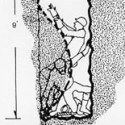|
I'm thinking about installing recessed lighting when I my upstairs bedroom. (we're pulling down all the plaster and drywalling over the lathe) Since the area above the ceiling is the eave of the attic (joists don't let me get any higher with the ceiling), the ceiling height is limited to just over 6'. Are there height requirements for recessed lighting? I feel like there is a potential for people to accidentally reach up and put their hand into the can, since I used to punch the ceiling accidentally while stretching.
|
|
|
|

|
| # ? May 14, 2024 03:06 |
|
I'm pretty sure the NEC doesn't limit height unless water is involved, in which case its a certain measurement from the potential nearest point of water (fill line of a tub, edge of a shower, etc). If your worry is people shocking themselves..always keep the cans occupied! If your worrie is people burning themselves or breaking bulbs, use either CLFs or LEDs. CFLs are way less hot and are a thicker glass thats harder to break and won't really shock you if you do. LEDs make even less heat and are very hard to break and have virtually no chance of shock if they are broken. The glass is usually very thick and somewhat plastic like and will crack more than really shatter. They also make enclosed cans that have a cover on them. You have to be careful about temperature so perhaps this is another good application for either lower wattage CFLs or LEDs. These covers would petty much solve your "punching the light when yawning" problem.
|
|
|
|
Since you'd be putting this can into the attic, there actually are cans specifically rated to be in direct contact with insulation. Use one of those if this is the case. actually, on second thought, I'd need a picture of the bathroom before I could recommend light placement.
|
|
|
|
Get a recessed light that's rated "IC" for in-contact-with-insulation. Get a trim with a lens. Make sure your can can take whatever lamp you want. 13- or 26-watt CFLs are pretty bright in cans. Get a trim with an enclosed lens. Alternatively, check on LED fixtures that are good for low-ceiling downlighting. LEDs typically have a fairly narrow cone, so aren't good for area light, but neither are recessed cans. You may want to check into an LED strip fixture. They're super-thin, reasonably bright, and have good area lighting. Also, it's lath. A lathe is a rotary machine.
|
|
|
|
Dragyn posted:Are there height requirements for recessed lighting? I feel like there is a potential for people to accidentally reach up and put their hand into the can, since I used to punch the ceiling accidentally while stretching. I don't think can lights will work well in your situation because they put out a cone of light, and you'd need to put them much closer together than normal in order to illuminate the area. You might want to look at more traditional flush-mount fixtures. Would a wall sconce work?
|
|
|
|
grover posted:NEC has restrictions on what kind of outlets can be placed in closets and attics due to the fire risk of bulbs being smashed. I don't think there is a legal code restriction for your case, but it would make sense to treat it as if there is a restriction and buy an enclosed fixture. You should be able to find one that either flush mounts or pretty close to it. Thanks for the responses. Here's a photo of the room in question.  Click here for the full 478x800 image. It's a bedroom, not a bath, and there isn't even heat plumbing in the room. the walls are much too low because of the sloped roof for sconces I think. I like the idea of covered cans, do you think the room is small enough that the cone of light would be enough?
|
|
|
|
Thats a pretty narrow room. With the way the ceiling is i think a row of covered cans down the center would look pretty cool. Could do LED strips but the light quality of CFL or LED bulbs is probably better. Alternate idea: could do sky light/light tunnel of some sort since you're so close to the roof if you wanted natural light, with a can or two or even just a lamp for nighttime lighting.
|
|
|
|
Not to nitpick, but have you thought of how you're going to run plumbing for the toilet, bath and sink in this room? You might want to replace the window glass with frosted glass instead. Some room dimensions would be nice too. You'll definitely want some type of brighter, surface mount fixture over the sink, since that's where people make themselves not fugly. What about tiltable cans in the slopes? They have even smaller light cones though...
|
|
|
|
I think this would look good hanging right in the middle of your room: Jokes aside, recessed cans with parabolic bulbs are used by designers for a specific type of light, and are not appropriate for general lighting of a room like this. Wider recessed fixtures have a better angle from the light source to other parts of the room, and will give better coverage. Something designed for flush-mounting in dropped ceilings might work well.
|
|
|
|
kid sinister posted:Not to nitpick, but have you thought of how you're going to run plumbing for the toilet, bath and sink in this room? You might want to replace the window glass with frosted glass instead. Some room dimensions would be nice too. grover posted:I think this would look good hanging right in the middle of your room: kid sinister, I'm not sure where bathroom is coming from, I only mentioned bedroom. Bathroom was originally part of the idea, but for exactly the reason you mentioned, it's pretty much a no-go. No ceiling clearance, no good way to run plumbing through the floor below. grover, as much as I would love a fan in that room (right at neck height, I might add), I'll have to pass. Don't fluorescent fixtures output the sort of light most people don't want in their homes though? Maybe it would be possible to use some sort of track lighting around the corners or the room?
|
|
|
|
CFLs (and normal fluorescent tubes) are available in a variety of color temperatures to suit your tastes. There are a variety of brands offering different features too such as instant start, dimming, different shapes, etc. There are more variety of CFLs on store shelves than incandescent these days. The only downside I've had with CFLs is that even the "instant on" ones have some warmup on really cold days. I've switched locations where this matters to LED bulbs and the problem is eliminated. LED lighting used to be a novelty but now they are appearing in more varieties than before in retail stores. My local Home Depot carries greater than 10 LED light bulbs, many of them in form factors that you can't tell aren't a light bulb if they're in a socket. They actually look more incandescent like because they dont have the the twirly shape a CFL has.
|
|
|
|
Compact Florescent lights come in many color temperatures. You could do track lighting, but it is usually is somewhat delicate. You can get recessed cans that will fit into your wall too, so thats a thought. On the topic of lighting, my cousin who has a medical marijuana license and is growing weed. He wants to save power and is convinced that having me install a 240v outlet for his lights will 'really save a bundle', I don't think this is true. My understanding is that a HPS light ballast is just a multi-tap transformer and a capacitor to correct power factor. He doesn't have one of the fancy electronic ones. Am I wrong in telling him it won't save any money?
|
|
|
|
tworavens posted:On the topic of lighting, my cousin who has a medical marijuana license and is growing weed. He wants to save power and is convinced that having me install a 240v outlet for his lights will 'really save a bundle', I don't think this is true. My understanding is that a HPS light ballast is just a multi-tap transformer and a capacitor to correct power factor. He doesn't have one of the fancy electronic ones. Am I wrong in telling him it won't save any money? You are not wrong. The ballast produces a certain number of VA to run the lamps. Wattage is wattage. It'll draw less current, but use the same amount of power. Electronic ballasts are slightly more efficient at 277/240 than at 120, but to 'really save a bundle' he'd have to be replacing like 200 of the things.
|
|
|
|
Dragyn posted:Don't fluorescent fixtures output the sort of light most people don't want in their homes though? Maybe it would be possible to use some sort of track lighting around the corners or the room?
|
|
|
|
Flipped through about half of this thread, and googled for a quick answer to no avail. I have a 90year old house, with mostly updated wiring (was k&t, then looks like an update in the 60s when a basement room was finished, and some more updating with romex and <10year old breakerbox/new line into the house.) I have a switch that controls the porch light that MY WIFE would like to be on a clock timer (on at 5 off at 8:30). Only the load is pulled into the box, and a tl;dr I need a timer switch (on at a specific time, off at another) that does not require neutral at the box.
|
|
|
|
XmasGiftFromWife posted:Flipped through about half of this thread, and googled for a quick answer to no avail. I have a 90year old house, with mostly updated wiring (was k&t, then looks like an update in the 60s when a basement room was finished, and some more updating with romex and <10year old breakerbox/new line into the house.) If there are more than one multiwire cable coming into the box, can you be more specific about how many wires and what colors are in each cable?
|
|
|
|
Would a light sensor/motion sensor on the light work for your wife? The light sensor gives the same on at dusk, off at dawn effect, without pulling tons of wire.
|
|
|
|
grover posted:If there are more than one multiwire cable coming into the box, can you be more specific about how many wires and what colors are in each cable? It is old wiring. There are three wires, all black insulated with "white" cotton on the outside. They are not bundled. One comes from the bottom of the box, and two come in separate punch-holes on the top. I had identified the hot using a DMM. The light is in an enclosed porch, so I am not sure how a dusk/dawn switch would work. (The switch is inside.)
|
|
|
|
You can get a photocell that is separate from your light fixture and install it outside your house, then wire from your light out to the photocell and back inside. This way you can still shut the light off if you want. I think your mystery wire is a neutral conductor that they just didn't hook up. If you could find where that wire comes from you might be able to hook the neutral up again.
|
|
|
|
XmasGiftFromWife posted:It is old wiring. There are three wires, all black insulated with "white" cotton on the outside. They are not bundled. One comes from the bottom of the box, and two come in separate punch-holes on the top. I had identified the hot using a DMM.
|
|
|
|
chedemefedeme posted:The only downside I've had with CFLs is that even the "instant on" ones have some warmup on really cold days. *The breaker may actually be 20A; it hasn't tripped yet, but when I tried to use a 15A surge-protector power strip as an extension cord it cut out as soon as I sparked the welder on high setting. Also, the "daylight" CFLs are not actually daylight color temp, according to my Nikon D2x.
|
|
|
|
Delivery McGee posted:Also, the "daylight" CFLs are not actually daylight color temp, according to my Nikon D2x. This is true. "Daylight" CFLs are only around 3400K, where as daylight is 5500K or 6500K depending on the standard you're using.
|
|
|
|
Delivery McGee posted:
Someone may be able to correct me on this, but I believe breakers are only guaranteed to trip once, beyond that, it can be a toss-up as to whether or not it will trip at all. Not that it doesn't stop people from flipping breakers to listen to wires rattle in the pipes. Anyhow, why not check your wire size (probably 14awg), check the rating on your breaker, maybe pull some 12 or 10 awg from the panel to the garage and replace that fire hazard waiting to happen? Better that than an insurance claim because a hot wire shorted after the insulation dried up and cracked, or melted away.
|
|
|
|
I've heard that they get more sensitive to trips with time, and that when they fail they should fail open. That is to say you won't be able to reset the breaker after a trip. Mostly they do just this. What type of circuit breaker are you using? If it is a GFCI or AFCI then something about they way your welder sparks combined with the surge protector might have tripped it. Do you have an actual 20 amp plug? I am pretty sure that most arc welders put out less then 50 volts and have a higher output amperage consequently. It could be that there is something wrong with your arc welder, did it do this before? FYI: The standard flat bladed receptacles you see in most outlets is for 15 amps max, and all manufacturers limit devices to that. The advantage putting those receptacles is not that you could run 20 amps out of any single one, but that you could run many with a load adding up to 20 amps. A 20 amp 125 volt receptacle has a sideways T for a neutral. The plug will match the receptacle. Look up NEMA type 5-20r to see a picture.
|
|
|
|
No, the surge protector's internal breaker tripped, the "real" breaker did not. And the welder manual says to use a 15A-rated extension cord; apparently the duty cycle when it's on the highest setting and pulling 20A is so low as to not actually be dangerous with 15A wiring. 
|
|
|
|
Wandering Idiot posted:Someone may be able to correct me on this, but I believe breakers are only guaranteed to trip once, beyond that, it can be a toss-up as to whether or not it will trip at all. Not that it doesn't stop people from flipping breakers to listen to wires rattle in the pipes. Do you mean for the lifetime of the breaker, or for one incident? tworavens posted:I've heard that they get more sensitive to trips with time, Most standard (non GFCI, non arc fault) breakers are thermal. If you've just tripped it, it's still warm and won't take much to trip it again until it cools down. Over the useful life span of the breaker this shouldn't be significantly changed, as the portions of the breaker that make it trip are just one or more tension springs and a bimetal spring that deforms with heat. None of these things should significantly wear/break unless there was a major over current event like a lightning strike. I'd wager that most people who think their problem breaker has "worn out" and replace it to find the problem solved actually had poor conductivity on the bus or hot lead (causing heat) and a simple cleaning and reinstallation would have produced the same results. Delivery McGee posted:*The breaker may actually be 20A; it hasn't tripped yet, but when I tried to use a 15A surge-protector power strip as an extension cord it cut out as soon as I sparked the welder on high setting. Most surge supressor strips are (overpriced) garbage with very poor tolerances. Having one trip below its rated threshold or not trip above its threshold should not come as any sort of surprise. Motronic fucked around with this message at 21:05 on Feb 25, 2011 |
|
|
|
Oddly enough, I heard that line about breakers from a substitute instructor in class. If I see him again, I'll pose the question back to him. He's a strange hat, though. Your explanation makes more sense, however, so, thank you.
|
|
|
|
Motronic posted:Most surge supressor strips are (overpriced) garbage with very poor tolerances. Having one trip below its rated threshold or not trip above its threshold should not come as any sort of surprise. Yeah, that's what I was thinking. The welder manual does say you should have a slow-blow fuse on that 15A circuit you're pulling 20A from. Duty cycle at max power is like 10%.
|
|
|
|
Where I heard about breakers becoming more sensitive over time was from an engineer doing a study at a Georgia Pacific plant in my town. They found that the circuit breakers would trip at 15-20% less current then rated after about 15 years. I'm not saying it is true in all cases, but that is what I heard and why I believe that.
|
|
|
|
babyeatingpsychopath posted:Aluminum is still also very very common for feeders, 250MCM and above... I've seen bus bars that were aluminum - I think 3000A capacity. However I've also seen places that won't permit any aluminum conductors or busses. tworavens posted:I've heard that they get more sensitive to trips with time, and that when they fail they should fail open. That is to say you won't be able to reset the breaker after a trip. Mostly they do just this. I've seen molded-case single-pole breakers that seemed to nuisance trip over time, especially when they were continually used at/near their capacity. The solution was to install properly sized breakers, as well as upgrading the wires fed from the breakers. (You cannot just slap in a bigger fuse/breaker without inspecting the wire size to make sure it's properly protected by the new breaker/fuse.) As far as capacity goes, unless they are 100% rated, breakers should not continually draw more than 80% of their rated current. I believe the fail-open standpoint is correct, but breakers had been recalled in the past for failing to open, overheating, etc. Mechanically most breakers have what is called a "trip free" design. That means that even if the handle is mechanically blocked or fails in the closed position, the circuit breaker will still trip and open the circuit. By the way, beware counterfeit circuit breakers! I've seen warnings that span from your standard 20A single/dual pole breakers all the way up to three-pole molded case breakers in the >100A range. Counterfeit Square-D Breakers Counterfeit Eaton Breakers Motronic posted:Most standard (non GFCI, non arc fault) breakers are thermal. If you've just tripped it, it's still warm and won't take much to trip it again until it cools down. For the folks interested learning about this, to my knowledge there are a few types of trip units: 1. Thermal (as mentioned by Motronic) 2. Magnetic (picks up from a sudden surge of current caused by a short-circuit somewhere past the breaker) 3. Thermal-magnetic (breaker that has both trip units) 4. Electronic (looks at current from a set of current transformers, has a little computer that signals to trip if there's a short or overload. More sophisticated protection relays also look at voltage, but those are typically for really f-ing big electrical devices. Typically not seen in residential/commercial stuff.) Three-Phase fucked around with this message at 15:00 on Mar 5, 2011 |
|
|
|
Three-Phase posted:I've seen bus bars that were aluminum - I think 3000A capacity. However I've also seen places that won't permit any aluminum conductors or busses. Contractors will submit aluminum bus bars all the time because they're cheaper. Copper bussing is probably my most common comment on 16400 submittals (with no tapered bussing as a close second).
|
|
|
|
Moved into a new house a bit ago and finally got around to figuring out why our overhead light only has two bulb sockets that work. Looks like I'll need to rewire the string of sockets. My main problem is that I can't seem to get the two sides of the plastic sockets apart! There is a metal brad/rivet that I cannot figure out how to get out and was wondering if anyone had some thoughts.
|
|
|
|
Sorry, the image does not seem to have attached...
|
|
|
|
Whenever we had to remove fasteners like that in the metal shop I worked in, we just used the drill press and a small bit to drill it out.
|
|
|
|
You should replace the lights completely in my opinion. Its not really worth fixing them.
|
|
|
|
tworavens posted:You should replace the lights completely in my opinion. Its not really worth fixing them. I would love to but suspect it would be hard to find something that would fit in the pre-existing fixture (this fancy crystal thingy). Any idea of what kind of store to go to?
|
|
|
|
I've seen stores where I live that seem to specialize in luminaries and lamps, but I'm not sure if a place like that could replace a fixture. Have you checked some larger hardware stores?
|
|
|
|
You could cut one of the wires in the 4-outlet section so you have something to splice to, and splice in a pigtail to connect the 3 loose ends.
grover fucked around with this message at 00:35 on Mar 9, 2011 |
|
|
|
In my experience, "sockets that don't work" just need the power turned off and the central tab to be bent up with a flathead screwdriver. Have you tried that?
|
|
|
|

|
| # ? May 14, 2024 03:06 |
|
So long story short -- found mold in our basement bathroom, tore it all out, rebuilt it from the ground up. Better, faster, stronger, more lights. Also a fan, which it didn't have previously (probably the main cause for the mold). The fan I bought has a fancy-schmancy humidity sensor and turns on automatically when it senses a rise in ambient moisture. I'd like to have the fan wired so that it's always powered, and the switch only controls the lights (a vanity light and two pot lights). Would this accomplish that?  > >edit: for table breakage Barnabas fucked around with this message at 17:58 on Mar 10, 2011 |
|
|










 Bad Angus! Bad!
Bad Angus! Bad!



